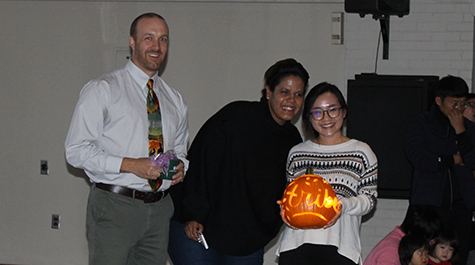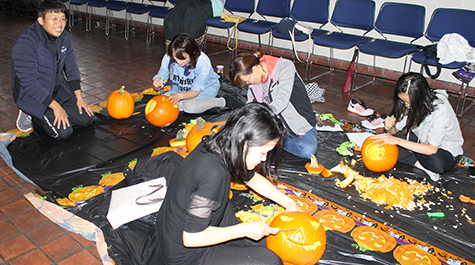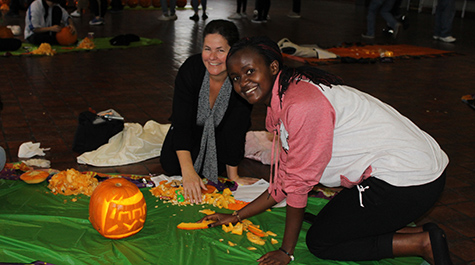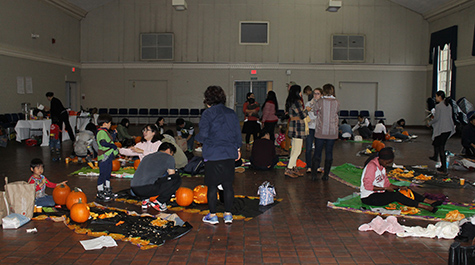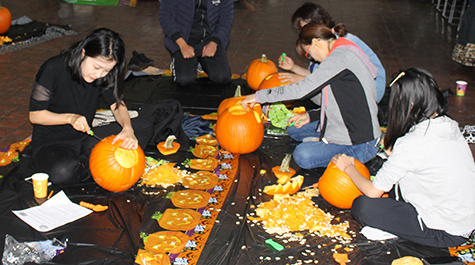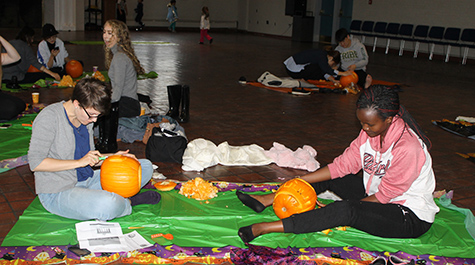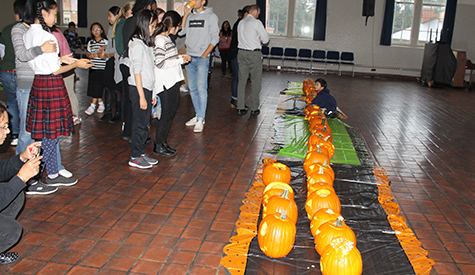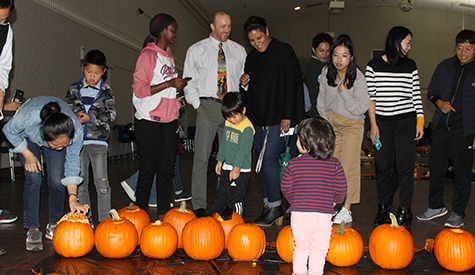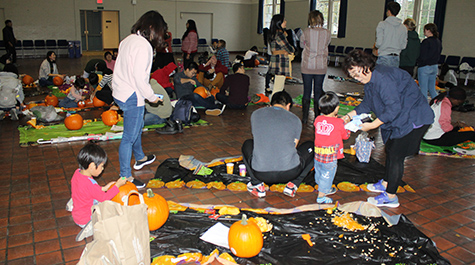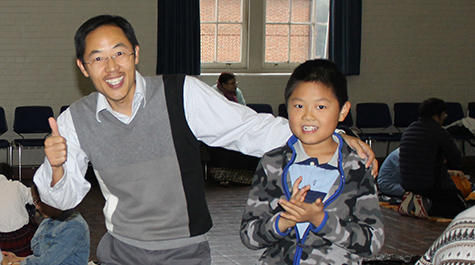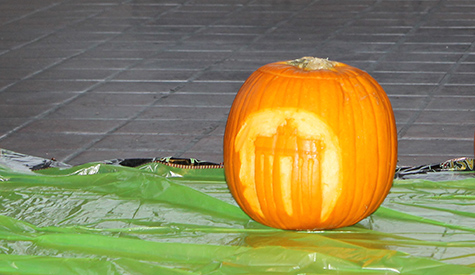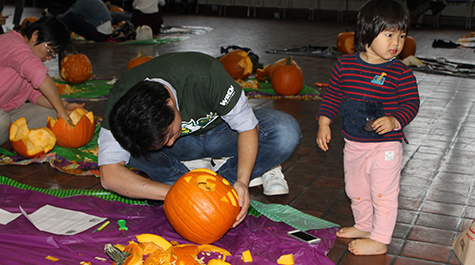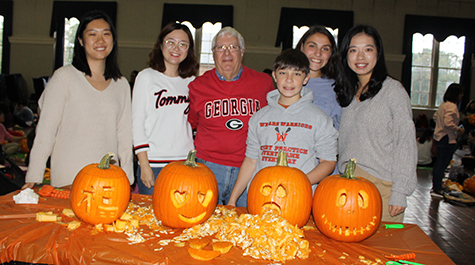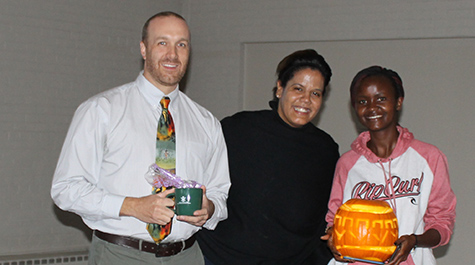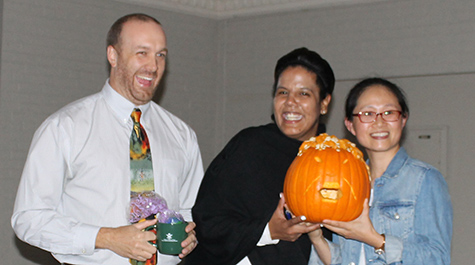The Reves Center's Pumpkin Carve: Creative Diversity and Diverse Creativity
Carving pumpkins for Halloween may owe its origin to the Celtic people, but it is now a firmly ensconced piece of Americana. And yet, for international students and scholars the tradition of creating a jack-o’-lantern for their porch is most likely something they know only from films or TV. While in Williamsburg, they may see pumpkins appear on stoops and decorations in stores, but being a curious spectator is the closest encounter they have.
For the staff of International Students, Scholars and Programs (ISSP), however, the whole point of immersing oneself in another culture is to, well, immerse oneself, and Halloween in the U.S. is something you have to experience to understand. It’s one thing to watch a pumpkin being carved, but the pressure of the knife struggling to break through the tough rind, the sliminess on your hands as you scoop out the pulp… a DIY video just won’t do the trick. And so in 2004, ISSP staff started a yearly Pumpkin Carve just before Halloween for international members of the William & Mary community.
The Recipe for Success
The event, which includes cider, treats and a friendly competition, is now one of the largest and most popular events ISSP manages. It brings together international students, scholars and their; families community members from the Global Friends Network. The age range runs from infants in arms, to first-graders in superhero costumes, to grandparents.
The logistics are impressive. Approximately 65 pumpkins are loaded up in the Reves van for “sacrifice” each year. Eva Wong, Assistant Director for International Programs; Mona Starman, Community Programs Assistant; and Hannah Leich Graduate Assistant for International Programs are the linchpins that make it happen, with assistance from global friends network members and other volunteers and staff. The event is usually held on the lawn next to the Reves Center, but this year’s festival on Friday, October 26, was moved inside to Trinkle Hall because of a steady, all-day rain. The relentless downpour outside and subdued, filtered light of the hall didn’t do anything to dampen spirits and actually added some appropriately spooky fall atmosphere. Spread out on plastic tarps all over the floor were small groups of students and families, engrossed in transforming their squash into art. The hall was replete with creativity, laughter and pumpkin innards.
“Every pumpkin has a jack-o’-lantern inside it, and it is the task of the carver to discover it” – Michelangelo’s brother and squash salesman
Each team – whether working alone, in pairs, or in family groupings – received pumpkin(s), plastic sheeting for the floor, and various implements for carving. Techniques varied, regardless of nationality. There were the pre-planners, arriving with stencils or blueprints, taking care to sketch a design before reaching for a knife. Others jumped right in, sawing away, inspiration and the rind’s terrain to guide them. Some carefully separated the mass of tangled seeds and pulp for disposal. Others embraced the mess, using it for their design… as hair, cascading water, or -- to the delight of the 10 and under set and young at heart -- vomit. One young woman from Germany opted not to open the pumpkin at all and etched the Brandenburg Gate in bas-relief.
At 4:30pm, everyone lined up their finished efforts to await the judge’s decision. This year’s special guest judge was Dania Matos, Deputy Chief Diversity Officer. It was her first Pumpkin Carve, but to no one’s surprise, she rose to the challenge and brought her own brand of charm, humor and ingenuity to the task. She and Steve Sechrist, Director of ISSP, inspected the long line of some two dozen pumpkins, some of which were lit by candles, some by cell phones.
Perhaps the best sign of the success of the event was that even though there would be only three winners, it almost seemed irrelevant to everyone’s enjoyment. They were excited and waited for the announcement from Sechrist and Matos, taking selfies with their pumpkins, a mix of laughter and various languages filling the hall. There was no evidence of competitive angst or jockeying for attention. They’d had fun and learned a new skill.
Three Winners and One New Tradition
But alas, it was a contest, and three winners needed to be selected: Most Creative, Most Traditional and Most International. In previous contests, the “Most Traditional” selection was something akin to a typical American jack-o’-lantern, with some variation of a toothy, crooked grin and two triangular shaped eyes. Matos decided this year, however, to interpret “traditional” in a non-traditional way, as meaning traditional for the artist’s own culture. To everyone’s delight, Matos selected the pumpkin created by Solange Umuhoza, who had modeled her pumpkin after a traditional Rwandan drum.
The winners were:
- Most Traditional: Solange Umuhoza ’22 (Rwanda)
- Most International: Jenny Fam, MA ’20 (Malaysia)
- Most Creative: Mei Zhong, spouse of the Chinese Director of the W&M Confucius Institute (China)
The Greatest Pumpkin
Steve Sechrist reports that when he visits international alumni overseas, the most frequently mentioned happiest memory they have of W&M is the annual pumpkin carving. And why not? It introduces people to something new, allows them to express themselves in a safe, non-judgmental environment that welcomes people from all backgrounds, abilities and ages and lets them learn about differences and also try something without fear of failure or being singled out. Sounds like a model for success. Or as Linus described so eloquently in The Great Pumpkin: “I don’t see how a pumpkin patch can be more sincere than this one. You can look around and there’s not a sign of hypocrisy. Nothing but sincerity as far as the eye can see.”
 Skip to main content
Skip to main content

